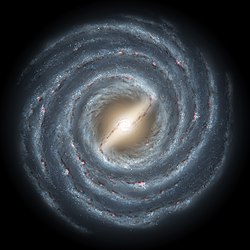Ursa-Minor-Zwerggalaxie
| Galaxie Ursa-Minor-Zwerggalaxie | |
|---|---|
 | |
| AladinLite | |
| Sternbild | Kleiner Bär |
| Position Äquinoktium: J2000.0, Epoche: J2000.0 | |
| Rektaszension | 15h 09m 08,5s[1] |
| Deklination | +67° 13′ 21″[1] |
| Erscheinungsbild | |
| Morphologischer Typ | dE/dSph |
| Helligkeit (visuell) | 11,9 mag |
| Winkelausdehnung | 30,2' × 19,1'[1] |
| Physikalische Daten | |
| Zugehörigkeit | Lokale Gruppe |
| Radialgeschwindigkeit | (-247 ± 1) km/s[1] |
| Entfernung | (240 ± 36) *10³ Lj / (73 ± 11) *10³ pc [2] |
| Metallizität [Fe/H] | [Fe/H] ˜ -2 |
| Geschichte | |
| Entdeckung | Albert George Wilson[1] |
| Entdeckungsdatum | 1954[1] |
| Katalogbezeichnungen | |
| UGC 9749 • PGC 54074 • CGCG 318-018, 319-001 • MCG +11-18-30 • DDO 199 | |
Die Ursa-Minor-Zwerggalaxie ist eine elliptische Zwerggalaxie im Sternbild des Kleinen Bären. Sie wurde 1954 von Albert George Wilson am Lowell-Observatorium entdeckt und ist ein Trabant der Milchstraße.
Eigenschaften
Die Galaxie besteht hauptsächlich aus einer älteren Sternpopulation und zeigt kaum bis gar keine aktuelle Sternentstehung. Im Jahr 1999 konnten die Astrophysiker Kenneth Mighell und Christopher Burke mit Hilfe des Hubble-Weltraumteleskops zeigen, dass in der Ursa-Minor-Zwerggalaxie nur eine einzige Sternentstehungsphase bis vor etwa 11 Milliarden Jahren stattfand, die etwa 2 Milliarden Jahre lang andauerte.[3][4]
Siehe auch
- Liste der Galaxien der Lokalen Gruppe
- Liste der Satellitengalaxien der Milchstraße
Einzelnachweise
- ↑ a b c d e NASA/IPAC Extragalactic Database
- ↑ Karachentsev, I. D.; Kashibadze, O. G.: Masses of the local group and of the M81 group estimated from distortions in the local velocity field. In: Astrophysics. 49. Jahrgang, Nr. 1, 2006, S. 3–18, doi:10.1007/s10511-006-0002-6, bibcode:2006Ap.....49....3K.
- ↑ Sidney van den Bergh: Updated Information on the Local Group. In: The Publications of the Astronomical Society of the Pacific. 112. Jahrgang, Nr. 770, April 2000, S. 529–536, doi:10.1086/316548, arxiv:astro-ph/0001040, bibcode:2000PASP..112..529V.
- ↑ Kenneth J. Mighell, Christopher J. Burke: WFPC2 Observations of the Ursa Minor Dwarf Spheroidal Galaxy. In: Astronomical Journal. 118. Jahrgang, Nr. 770, 1. März 1999, S. 366–380, doi:10.1086/300923, arxiv:astro-ph/9903065, bibcode:2000PASP..112..529V.
Weblinks
Auf dieser Seite verwendete Medien
Autor/Urheber: Giuseppe Donatiello from Oria (Brindisi), Italy, Lizenz: CC0
Ursa Minor Dwarf Composite Public data/Giuseppe Donatiello
J2000.0 RA 15h 09m 08.5s DEC +67° 13′ 21″ The Ursa Minor Dwarf is a dwarf spheroidal galaxy, discovered by A.G. Wilson of the Lowell Observatory, during the Palomar Sky Survey in 1955 in the Ursa Minor, and is a satellite galaxy of the Milky Way distant 225,000 light-years.
The galaxy consists mainly of old stars and seems to house little to no ongoing star formation.Caption from NASA: Like early explorers mapping the continents of our globe, astronomers are busy charting the spiral structure of our galaxy, the Milky Way. Using infrared images from NASA's Spitzer Space Telescope, scientists have discovered that the Milky Way's elegant spiral structure is dominated by just two arms wrapping off the ends of a central bar of stars. Previously, our galaxy was thought to possess four major arms.
This artist's concept illustrates the new view of the Milky Way, along with other findings presented at the 212th American Astronomical Society meeting in St. Louis, Mo. The galaxy's two major arms (Scutum-Centaurus and Perseus) can be seen attached to the ends of a thick central bar, while the two now-demoted minor arms (Norma and Sagittarius) are less distinct and located between the major arms. The major arms consist of the highest densities of both young and old stars; the minor arms are primarily filled with gas and pockets of star-forming activity.
The artist's concept also includes a new spiral arm, called the "Far-3 kiloparsec arm," discovered via a radio-telescope survey of gas in the Milky Way. This arm is shorter than the two major arms and lies along the bar of the galaxy.
Our sun lies near a small, partial arm called the Orion Arm, or Orion Spur, located between the Sagittarius and Perseus arms.

